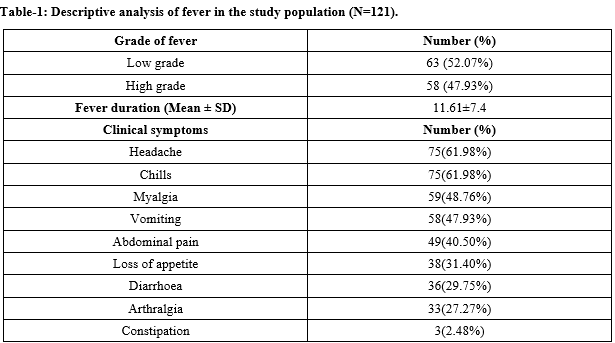Clinical and microbiological profile of enteric fever in a tertiary care hospital
Abstract
Background: Enteric fever is largely prevalent in India. This study is done to know the clinical profile of typhoid & paratyphoid fever and to study the pattern of antimicrobial susceptibility among Salmonella species.
Materials and Methods: This observational hospital based prospective study was conducted from August 2015 to December 2016 in patients admitted in medicine department of a tertiary hospital. The clinically suspected cases were diagnosed by blood culture, stool culture, Widal test and Typhoid test. The antimicrobial susceptibility pattern of Salmonella species was isolated.
Results: 121 cases of clinically suspected entericfever were found to be either blood culture positive or serology positive for enteric fever. The mean age of the participants was 30.55±12.65 years with 76 (62.81%) males and 45 (37.19%) females. The most common symptom were fever, headache and chills. Other findings were bradycardia 67(55%), abdominal tenderness 25 (21%), splenomegaly 32 (26%) and hepatomegaly 14 (11.5%). Blood culture was done in 80 patients, 6 were growing S. typhi; 28 were growing S. paratyphi. Out of 107 cases Widal was done, 42 Widal positive for typhoid fever; 37 was paratyphoid positive, 28 Widal negative. Out of 121 cases, 53 were paratyphoid, 58 were typhoid fever, 10 were diagnosed based on clinical criteria of enteric fever. All the isolates were sensitive to ceftriaxone.
Conclusion: This study points to a higher yield of enteric fever by blood culture, also the no of paratyphoid cases is relatively higher as compared to typhoid cases.
Downloads
References
2. Kanungo S, Dutta S, Sur D. Epidemiology of typhoid and paratyphoid fever in India. J Infect Dev Ctries. 2008 Dec1;2(6):454-60.doi.org/10.3855/jidc. 161
3. Banerjee T, Shukla BN, Filgona J, Anupurba S, Sen MR. Trends of typhoid fever seropositivity over ten years in north India. The Indian journal of medical research. 2014 Aug;140(2):310.
4. Connor BA, Schwartz E. Typhoid and paratyphoid fever in travellers. Lancet Infect Dis. 2005 Oct;5 (10):623-8. DOI:10.1016/S1473-3099(05)70239-5
5. Sen B, Dutta S, Sur D, Manna B, Deb AK, Bhattacharya SK, et al. Phage typing, biotyping& antimicrobial resistance profile of Salmonella enterica serotype Typhi from Kolkata. Indian J Med Res. 2007 May; 125(5):685-8.
6. Krishnan P, Stalin M, Balasubramanian S. Changing trends in antimicrobial resistance of Salmonella enterica serovar typhi and salmonella enterica serovar paratyphi A in Chennai. Indian J Pathol Microbiol. 2009 Oct-Dec; 52 (4):505-8. doi: 10.4103/0377-4929.56140.
7. Harish BN, Menezes GA. Antimicrobial resistance in typhoidal salmonellae. Indian J Med Microbiol. 2011 Jul-Sep;29(3):223-9. doi: 10.4103/0255-0857.83904.
8. Verma S, Thakur S, Kanga A, Singh G, Gupta P. Emerging Salmonella Paratyphi A enteric fever and changing trends in antimicrobial resistance pattern of salmonella in Shimla. Indian J Med Microbiol. 2010 Jan-Mar; 28(1): 51-3. doi: 10. 4103/ 0255-0857.58730.
9. Manual for laboratory diagnosis of common epidemic prone diseases for district public health laboratories. IDSP. NCDC, New Delhi. May 2011.
10. Manual for Laboratory Diagnosis of Common Epidemic Prone Diseases at District Public Health Laboratories [Internet]. National centre for disease control. 2009 [cited 13 November 2016]. Available from: https://idsp.nic.in/WriteRead Data/OldSite/Lab_ Manual.pdf.
11. Chowta MN, Chowta NK. Study of clinical profile and antibiotic response in typhoid fever. Indian J Med Microbiol. 2005 Apr;23(2):125-7.
12. Gupta S, Handa A, Chadha DS, Ganjoo RK, Panda RC. Profile of Culture Positive Enteric Fever from Bangalore. Medical journal, Armed Forces India. 2009; 65 (4):328-31. 10.1016/S0377-1237(09)80093-2
13. Iqbal N, Basheer A, Mookkappan S, Ramdas A, Varghese RG, Padhi S, Shrimanth B, Chidambaram S, Anandhalakshmi S, Kanungo R. Clinicopathological profile of salmonella typhi and paratyphi infections presenting as fever of unknown origin in a tropical country.Mediterranean journal of hematology and infectiousdiseases.2015;7(1).10.4084/MJHID.2015. 021
14. Mushtaq S, Bhat AA, Rather GN, Akhter R, Bhat I, Wani T. Clinical profile of enteric fever in tertiary care hospital of Kashmir. 2017. 2017;4(5):4.



 OAI - Open Archives Initiative
OAI - Open Archives Initiative


